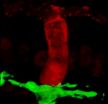(Press-News.org) New York, NY (March 14, 2012) — Columbia University Medical Center (CUMC) scientists have developed a way to recreate an individual's immune system in a mouse. The "personalized immune mouse" offers researchers an unprecedented tool for individualized analysis of abnormalities that contribute to type 1 diabetes and other autoimmune diseases, starting at the onset of disease. The findings were published today in the online edition of Science Translational Medicine.
The mouse model could also have clinical applications, such as predicting how a particular patient might respond to existing drugs or immunotherapies, reports senior author Megan Sykes, Michael J. Friedlander Professor of Medicine and Professor of Microbiology & Immunology and Surgical Sciences (in Surgery) at CUMC. Dr. Sykes is also Director for the Columbia Center for Translational Immunology. In addition, the model might prove useful for developing individualized immunotherapies for fighting infection or cancer or for lessening a patient's rejection of transplanted tissue.
Researchers have been searching for new ways to tease apart the various factors that contribute to autoimmune disease. "While large-scale studies of human populations have provided important clues to the genetic basis of immune diseases, they have offered little information about the specific role the genes play," says Dr. Sykes. "It's difficult to isolate these mechanisms when looking at groups of patients who have had disease for different lengths of time or have been receiving different treatments. And the fact that they already have the disease makes it difficult to distinguish what underlies and propagates the autoimmune process."
Several research groups have attempted to create a personalized immune mouse. However, each model has had significant limitations, such as an inability to generate the full complement of immune cells and incompatibilities between tissues used to recreate the human immune system, leading to graft-versus-host disease.
Dr. Sykes' model, in contrast, is able to recreate a robust and diverse human immune system, including T cells, B cells, and myeloid cells (which generate a variety of immune cells), free of immune incompatibilities.
The model is made by transplanting human bone marrow stem cells (also known as CD34+ cells), along with a small amount (approximately 1 cubic mm) of HLA-matched immature thymus tissue, into an immunodeficient mouse. (The HLA, or human leukocyte antigen, system mediates interactions among various immune cells.) The thymus tissue is implanted into the mouse's kidney capsule, a thin membrane that envelops the kidney and serves as an incubator. Within six to eight weeks, the transplanted thymus tissue is seeded by circulating human CD34+ cells (which are infused into the mouse's bloodstream), and begins generating human immune cells from the CD34+ cells.
A key to the model's success was the team's discovery that freezing and thawing the transplanted thymus tissue, as well as administering antibodies against CD2 (a glycoprotein that mediates T cell development and activation), depletes mature T cells from the tissue graft. This prevents rejection of the human CD34+ cells and graft-versus-host disease, while preserving function of the thymus tissue.
Dr. Sykes intends to use the personalized immune mouse to study type 1 diabetes. "We hope to find out what is fundamentally different about patients' immune systems, compared with those of healthy individuals, before any disease develops," she says.
The studies should also reveal more about the genetics of type 1 diabetes. "A number of HLA-associated genes have been linked to type 1 diabetes," she explains. "About a third of the population has one of more of these genes. But a much smaller percentage of the population actually develops the disease. What this means is, the HLA genes are necessary, but not sufficient, to cause type 1 diabetes. Using the personalized immune mouse, we expect to learn more about the role that non-HLA genes play in the disease."
###
Dr. Sykes' paper is entitled, "A model for personalized in vivo analysis of human immune responsiveness." Her coauthors are Hannes Kalscheuer (Harvard Medical School, Boston, MA, and CUMC), Nichole Danzl (CUMC), Takashi Onoe (Harvard and CUMC), Ted Faust (Harvard and CUMC), Robert Winchester (CUMC), Robin Goland (CUMC), Ellen Greenberg (CUMC), Thomas R Spitzer (Harvard), David G. Savage (CUMC), Hiroyuki Tahara (CUMC), Goda Choi (CUMC), and Yong-Guang Yang (Harvard and CUMC).
The researchers declare no financial or other conflict of interest.
This research was supported by JDRF Autoimmunity Center at Harvard University and by NIH grant #RO1 AI084903.
Columbia University Medical Center provides international leadership in basic, pre-clinical and clinical research, in medical and health sciences education, and in patient care. The medical center trains future leaders and includes the dedicated work of many physicians, scientists, public health professionals, dentists, and nurses at the College of Physicians and Surgeons, the Mailman School of Public Health, the College of Dental Medicine, the School of Nursing, the biomedical departments of the Graduate School of Arts and Sciences, and allied research centers and institutions. Established in 1767, Columbia's College of Physicians and Surgeons was the first institution in the country to grant the M.D. degree and is among the most selective medical schools in the country. Columbia University Medical Center is home to the largest medical research enterprise in New York City and State and one of the largest in the United States.
END
CLEVELAND -- A catheter procedure that closes a hole in patients' hearts was no more effective than medical therapy in preventing recurrent strokes, according to a new study published in the March 15 issue of the New England Journal of Medicine.
In the CLOSURE I trial, clinical researchers compared a catheter procedure plus medical therapy with medications alone to prevent new strokes or transient ischemic attacks (TIAs) in patients between 18 and 60 years old with an unexplained ("cryptogenic") stroke or TIA and a patent foremen ovale (PFO) – a hole between the heart's ...
VIDEO:
Using two-photon imaging, the researchers were able to see dendritic cells, shown in green, in the intestine of a living mouse.
Click here for more information.
With every meal, immune cells in the intestine stand like sentries at a citadel, turning away harmful bacteria but allowing vitamins and nutrients to pass.
Now, researchers at Washington University School of Medicine in St. Louis have identified the cells that chaperone food antigens, or proteins, in the ...
Of the $25 billion federal settlement funds for mortgage foreclosure abuses, Wisconsin will receive $140 million. The settlement money is being paid by J.P. Morgan Chase, Bank of America, Wells Fargo & Co, Citigroup and Ally (formerly GMAC), and is intended to help homeowners having difficulty making their mortgage payments and individuals who were the victims of improper foreclosures.
According to Assistant Attorney General Holly Pomraning in a recent TheNorthwestern.com article, Wisconsin's share of the settlement will be divided and distributed as follows:
- ...
Foodborne disease outbreaks caused by imported food appeared to rise in 2009 and 2010, and nearly half of the outbreaks implicated foods imported from areas which previously had not been associated with outbreaks, according to research from the Centers for Disease Control and Prevention, presented today at the International Conference on Emerging Infectious Diseases in Atlanta.
"It's too early to say if the recent numbers represent a trend, but CDC officials are analyzing information from 2011 and will continue to monitor for these outbreaks in the future," said Hannah ...
A team of researchers led by scientists at The Rockefeller University has identified a novel mechanism by which influenza interferes with antiviral host response. The finding, reported in this week's issue of the journal Nature, shows that the immunosuppressive NS1 protein of the influenza A virus hijacks key regulators of antiviral gene function by mimicking a core component of gene regulating machinery. The results they describe have major implications for our understanding of the biology of seasonal influenza virus and its pathogenesis. This research also suggests a ...
There was a lot of excitement a few years ago following the discovery of the DNA origami technique. The approach could be used to build nanoparticles of a given shape and size. However, real applications, such as nano-tweezers, remained out of reach. An international team of researchers led by Professor Tim Liedl of the Ludwig-Maximillians-Universitaet Muenchen and Professor Friedrich Simmel of the Technische Universitaet Muenchen have now succeeded in building nanoparticles using optically active DNA building blocks that can be used to modify light in very specific ways.
Coupling ...
STANFORD, Calif. -- A week ago, you started a new prescription medication for acne. Today, you feel dizzy and short of breath and have difficulty concentrating. Your symptoms are not listed in the package insert as possible side effects of the drug, but why else would you be feeling so odd?
Unfortunately, there's no easy answer. Clinical trials are designed to show that a drug is safe and effective. But even the largest trials can't identify irksome or even dangerous side effects experienced by only a tiny proportion of those people taking the drug. They also aren't designed ...
Menlo Park, Calif. — Researchers from Stanford University and the U.S. Department of Energy's SLAC National Accelerator Laboratory have created the first-ever system of "designer electrons" – exotic variants of ordinary electrons with tunable properties that may ultimately lead to new types of materials and devices.
"The behavior of electrons in materials is at the heart of essentially all of today's technologies," said Hari Manoharan, associate professor of physics at Stanford and a member of SLAC's Stanford Institute for Materials and Energy Sciences, who led the research. ...
Families throughout the nation continue to struggle financially. In fact, the prospect of economic stability continues to look so grim professionals have coined this period of time the Great Recession. Many depend on unemployment benefits to make ends meet during these difficult times, but what happens when they run out?
Now, more and more people are looking to Social Security Disability benefits when their unemployment ends. Whether people were disabled before their unemployment began or became disabled while receiving unemployment, Social Security Disability offers ...
In preclinical studies, researchers at SRI International and Astraea Therapeutics have recently evaluated the role of a new drug receptor target that shows promise for the treatment of drug addiction.
This potential new drug target belongs to a class of receptors called the nicotinic acetylcholine receptors (nAChRs). One subtype of nAChRs, called alpha4beta2 is a well-known target for nicotine's addictive effects and the therapeutic effect of the smoking cessation drug varenicline. SRI researchers are now studying another, lesser-known subtype, called alpha3beta4 nAChR, ...


